Themed collection New era in advanced functional materials emerging from molecular imprinting and related techniques

Introduction to New era in advanced functional materials emerging from molecular imprinting and related techniques
Professor Karsten Haupt, Professor Toshifumi Takeuchi and Professor Guoping Chen introduce the Journal of Materials Chemistry B themed issue on a New era in advanced functional materials emerging from molecular imprinting and related techniques.

J. Mater. Chem. B, 2022,10, 6570-6570
https://doi.org/10.1039/D2TB90120J
Molecularly imprinted materials for glycan recognition and processing
Molecularly imprinted materials are uniquely suited for glycan recognition. Biologically competitive binding and selective hydrolysis of glycans are achieved through innovation in imprinting techniques and postmodification of the imprinted sites.
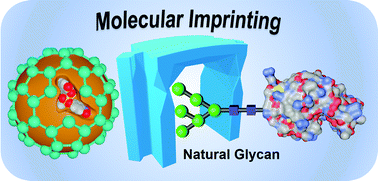
J. Mater. Chem. B, 2022,10, 6607-6617
https://doi.org/10.1039/D2TB00164K
Recent development in the design of artificial enzymes through molecular imprinting technology
Recent advances in the preparation of high-performance artificial enzymes based on MIPs and molecularly imprinted nanozymes.
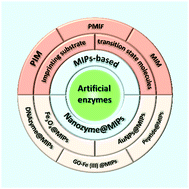
J. Mater. Chem. B, 2022,10, 6590-6606
https://doi.org/10.1039/D2TB00276K
Recent advances in protein-imprinted polymers: synthesis, applications and challenges
This review summarized the recent advances of protein imprinted polymers (PIPs) focused on the imprinting methods and highlighted applications.
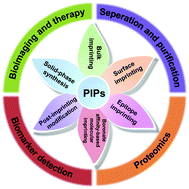
J. Mater. Chem. B, 2022,10, 6571-6589
https://doi.org/10.1039/D2TB00273F
A multi-site recognition molecularly imprinted solid-phase microextraction fiber for selective enrichment of three cross-class environmental endocrine disruptors
A multi-site recognition MIP fiber for cross-class EED enrichment.
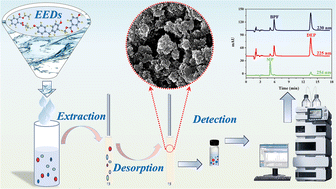
J. Mater. Chem. B, 2023,11, 1020-1028
https://doi.org/10.1039/D2TB02156K
An organic transistor for the selective detection of tropane alkaloids utilizing a molecularly imprinted polymer
An organic transistor functionalized with a molecularly imprinted polymer (MIP) succeeded in the highly selective detection of chiral tropane alkaloids owing to the optimized internal molecular recognition sites in the MIP.

J. Mater. Chem. B, 2022,10, 6808-6815
https://doi.org/10.1039/D2TB01067D
Molecular imprinting as a simple way for the long-term maintenance of the stemness and proliferation potential of adipose-derived stem cells: an in vitro study
Culturing adipose-derived stem cells (ADSCs) on the biomimetic ADSC-imprinted substrate is a simple way for long-term maintenance of their stemness and proliferation potential.

J. Mater. Chem. B, 2022,10, 6816-6830
https://doi.org/10.1039/D2TB00279E
Detection of selective androgen receptor modulators (SARMs) in serum using a molecularly imprinted nanoparticle surface plasmon resonance sensor
NanoMIPs developed for three Selective Androgen Receptor Modulators (SARMs) are applied to an SPR sensor for <nM level serum detection.

J. Mater. Chem. B, 2022,10, 6792-6799
https://doi.org/10.1039/D2TB00270A
Specific recognition of a target protein, cytochrome c, using molecularly imprinted hydrogels
Specificity of molecular recognition for a protein, cytochrome c, by MIP hydrogels through optimization of the preparation and adsorption protocols.

J. Mater. Chem. B, 2022,10, 6800-6807
https://doi.org/10.1039/D2TB00501H
In vivo stealthified molecularly imprinted polymer nanogels incorporated with gold nanoparticles for radiation therapy
Gold-nanoparticle-incorporated molecularly imprinted nanogels acquire stealth capabilities in vivo through protein corona regulation using intrinsic dysopsonic proteins. The composite can be used in radiation therapy to treat mouse pancreatic cancer.
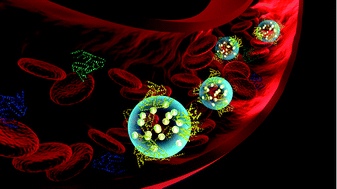
J. Mater. Chem. B, 2022,10, 6784-6791
https://doi.org/10.1039/D2TB00481J
Development of a microfluidic dispensing device for multivariate data acquisition and application in molecularly imprinting hydrogel preparation
We fabricated microfluidic dispensing devices, which can give the solution of different flow rates, successfully acquiring multivariate data on the adsorption capacity for protein imprinting hydrogels.
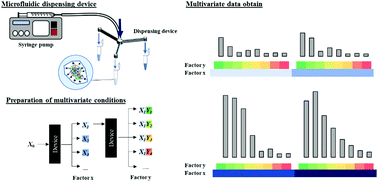
J. Mater. Chem. B, 2022,10, 6664-6672
https://doi.org/10.1039/D2TB00685E
A molecularly imprinted nanocavity with transformable domains that fluorescently indicate the presence of antibiotics in meat extract samples
A molecularly imprinted nanocavity that binds to antibiotics and wherein successful binding is indicated by a change in fluorescence, which can detect not only antibiotics in aqueous media of various pH values, but also in meat extract samples.
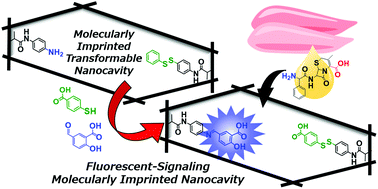
J. Mater. Chem. B, 2022,10, 6682-6687
https://doi.org/10.1039/D2TB00145D
Molecularly imprinted polymer nanogels targeting the HAV motif in cadherins inhibit cell–cell adhesion and migration
Molecularly imprinted polymer nanogels (MIPs) as synthetic antibody mimics against the HAVDI epitope of N-cadherin specifically inhibit cell–cell aggregation and tumor cell invasiveness by blocking cadherin-mediated interactions.
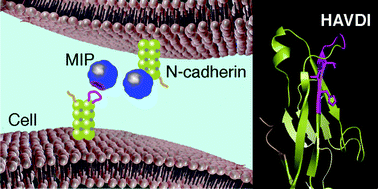
J. Mater. Chem. B, 2022,10, 6688-6697
https://doi.org/10.1039/D2TB00680D
A molecularly imprinted antibiotic receptor on magnetic nanotubes for the detection and removal of environmental oxytetracycline
The detection and elimination of antibiotic contaminants, such as oxytetracycline (OTC), a broad-spectrum tetracycline antibiotic, would be of help in efficient environmental monitoring, agriculture and food safety tests.

J. Mater. Chem. B, 2022,10, 6777-6783
https://doi.org/10.1039/D2TB00497F
An in silico predictive method to select multi-monomer combinations for peptide imprinting
Single monomer Virtual screening vs. Multi-monomer simultaneous docking for combinatorial screening and synthesis.
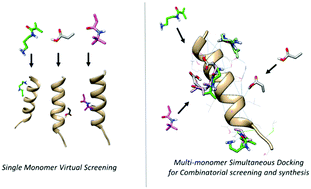
J. Mater. Chem. B, 2022,10, 6618-6626
https://doi.org/10.1039/D2TB00418F
Construction of nano receptors for ubiquitin and ubiquitinated proteins based on the region-specific interactions between ubiquitin and polydopamine
A strong region-specific interaction between ubiquitin and polydopamine was disclosed and employed to construct surface-imprinted magnetic nanoparticles for the enrichment of ubiquitin and ubiquitinated proteins from complex biological samples.
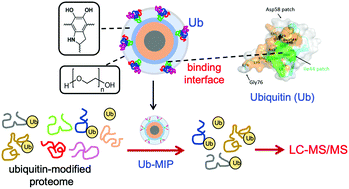
J. Mater. Chem. B, 2022,10, 6627-6633
https://doi.org/10.1039/D2TB00255H
Design of molecularly imprinted hydrogels with thermoresponsive drug binding sites
Thermoresponsive hydrogels with a controlled drug binding capacity were designed to create drug reservoirs capable of both inhibiting drug leakage below the transition temperature and accelerating drug release above it.
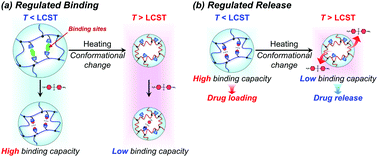
J. Mater. Chem. B, 2022,10, 6644-6654
https://doi.org/10.1039/D2TB00325B
Easy preparation of a liposome-mediated protein delivery system by freeze–thawing a liposome–protein complex
An easy one-step method for the encapsulation of proteins into liposomes based on freeze–thawing a protein–liposome complex was developed for efficient protein delivery.
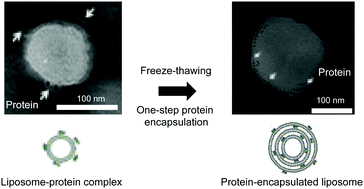
J. Mater. Chem. B, 2022,10, 6768-6776
https://doi.org/10.1039/D2TB00271J
An artificial antibody for exosome capture by dull template imprinting technology
Benefiting from the synergistic effect of dull template imprinting and electrostatic interaction, the artificial antibody can capture exosomes from biofluids.
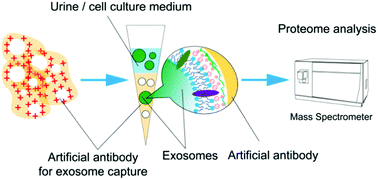
J. Mater. Chem. B, 2022,10, 6655-6663
https://doi.org/10.1039/D2TB00494A
Raman and scanning probe microscopy for differentiating surface imprints of E. coli and B. cereus
Nanomechanical AFM and Raman-Microscopy data give evidence that surface imprinting of bacteria leads to chemical differences in cavities caused by different species. This experimentally corroborates a fundamental assumption of molecular imprinting.
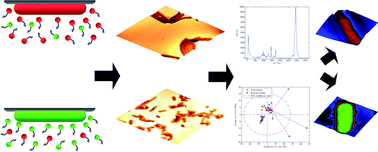
J. Mater. Chem. B, 2022,10, 6758-6767
https://doi.org/10.1039/D2TB00283C
Fluorescence detection of milk allergen β-lactoglobulin based on aptamers and WS2 nanosheets
A fluorescence assay is designed to detect β-Lg in food samples based on WS2 nanosheets and a fluorescent dye (FAM)-labeled β-Lg aptamer.

J. Mater. Chem. B, 2022,10, 6752-6757
https://doi.org/10.1039/D2TB00263A
Modulation of acetylcholinesterase activity using molecularly imprinted polymer nanoparticles
Epitope mapping and nanoMIP development lead to materials that modulate enzyme activity and promote reactivation after antagonist exposure.

J. Mater. Chem. B, 2022,10, 6732-6741
https://doi.org/10.1039/D2TB00278G
Molecularly imprinted wax
Molecularly imprinted wax (MIW) spheres were successfully prepared using wax as the matrix. Due to their phase-change merits at relatively low temperatures and excellent solubility in n-hexane, MIW spheres realized an elution-free SPE process.
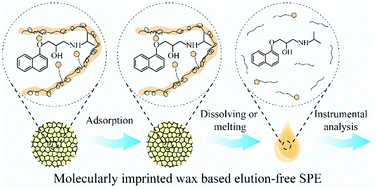
J. Mater. Chem. B, 2022,10, 6742-6751
https://doi.org/10.1039/D2TB00040G
Rabbit IgG-imprinted nanoMIPs by solid phase synthesis: the effect of cross-linkers on their affinity and selectivity
Rabbit IgG-imprinted nanopolymers were prepared by solid phase synthesis. Five different cross-linkers were used, evaluating the binding properties. The molecular structure of cross-linker influences of nanopolymer selectivity towards other proteins.
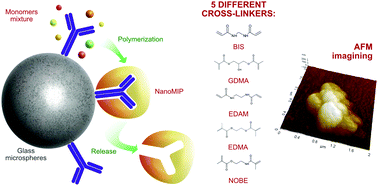
J. Mater. Chem. B, 2022,10, 6724-6731
https://doi.org/10.1039/D2TB00245K
Biological sample-compatible Au nanoparticle-containing fluorescent molecularly imprinted polymer microspheres by combining RAFT polymerization and Au–thiol chemistry
Au nanoparticle-containing fluorescent molecularly imprinted polymer microspheres with high folic acid optosensing selectivity and sensitivity in the undiluted urine samples are first developed by combining RAFT polymerization and Au–thiol chemistry.

J. Mater. Chem. B, 2022,10, 6673-6681
https://doi.org/10.1039/D2TB00179A
Multi-stimuli responsive molecularly imprinted nanoparticles with tailorable affinity for modulated specific recognition of human serum albumin
Novel multi-stimuli responsive molecularly imprinted polymers for the specific recognition and enrichment of serum albumin from complex blood samples.
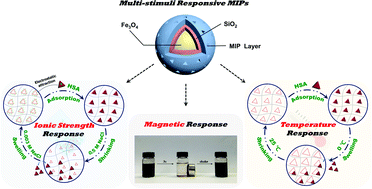
J. Mater. Chem. B, 2022,10, 6634-6643
https://doi.org/10.1039/D2TB00076H
Construction of DNA ligase-mimicking nanozymes via molecular imprinting
A strategy called affinity gathering-enhanced coupling and thermal cycling amplification is reported for designing enzyme-mimicking molecularly imprinted polymers. It is verified with mesoporous silica nanoparticles capable of ligating short ssDNA.
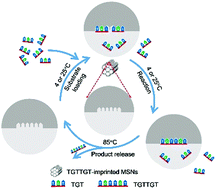
J. Mater. Chem. B, 2022,10, 6716-6723
https://doi.org/10.1039/D1TB02325J
Cilostazol-imprinted polymer film-coated electrode as an electrochemical chemosensor for selective determination of cilostazol and its active primary metabolite
An electrochemical chemosensor for cilostazol (CIL) determination was devised, engineered, and tested.
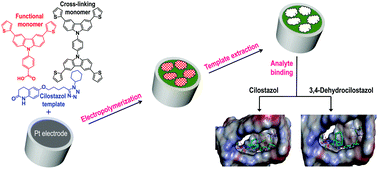
J. Mater. Chem. B, 2022,10, 6707-6715
https://doi.org/10.1039/D1TB02186A
Recyclable nanoparticles based on a boronic acid–diol complex for the real-time monitoring of imprinting, molecular recognition and copper ion detection
A simple, sensitive, and straightforward method is developed to study the process of molecular imprinting via real-time fluorescence measurements. The imprinted polymer can be used to remove ARS from water, and as a fluorescent probe to detect Cu2+.
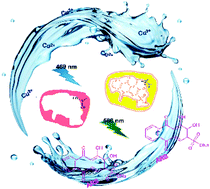
J. Mater. Chem. B, 2022,10, 6698-6706
https://doi.org/10.1039/D1TB02226A
About this collection
Recent developments in molecular imprinting and related technologies have attracted a great deal of attention in the field of materials science. Many scientists and engineers in academia and industry, in the analytical, biomedical, environmental and materials sciences are interested in molecularly imprinted polymers (MIPs). Unfortunately, the 11th International Conference on molecular imprinting (MIP2020), due to be held in Hiroshima (Japan), has been cancelled due to the COVID-19 pandemic. Even under such circumstances, work has continued to develop new MIPs.
Guest Edited by Toshifumi Takeuchi (Kobe University, Japan), Karsten Haupt (Université de Technologie de Compiègne, France), and Guoping Chen (National Institute for Materials Science, Japan), this themed issue of Journal of Materials Chemistry B aims to collect the latest information on MIP research, act as the most relevant venue for sharing new ideas and recent advances and accelerate future developments in molecular imprinting and related techniques, in place of the MIP2020 conference.